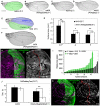Wingless promotes proliferative growth in a gradient-independent manner
- PMID: 19809090
- PMCID: PMC3000546
- DOI: 10.1126/scisignal.2000360
Wingless promotes proliferative growth in a gradient-independent manner
Abstract
Morphogens form concentration gradients that organize patterns of cells and control growth. It has been suggested that, rather than the intensity of morphogen signaling, it is its gradation that is the relevant modulator of cell proliferation. According to this view, the ability of morphogens to regulate growth during development depends on their graded distributions. Here, we describe an experimental test of this model for Wingless, one of the key organizers of wing development in Drosophila. Maximal Wingless signaling suppresses cellular proliferation. In contrast, we found that moderate and uniform amounts of exogenous Wingless, even in the absence of endogenous Wingless, stimulated proliferative growth. Beyond a few cell diameters from the source, Wingless was relatively constant in abundance and thus provided a homogeneous growth-promoting signal. Although morphogen signaling may act in combination with as yet uncharacterized graded growth-promoting pathways, we suggest that the graded nature of morphogen signaling is not required for proliferation, at least in the developing Drosophila wing, during the main period of growth.
Figures




References
-
- Ashe HL, Briscoe J. The interpretation of morphogen gradients. Development. 2006;133:385–394. - PubMed
-
- Tabata T, Takei Y. Morphogens, their identification and regulation. Development. 2004;131:703–712. - PubMed
-
- García-Bellido A. Genetic control of wing disc development in Drosophila. Ciba Found. Symp. 1975;0:161–182. - PubMed
-
- Johnston LA, Sanders AL. Wingless promotes cell survival but constrains growth during Drosophila wing development. Nat. Cell Biol. 2003;5:827–833. - PubMed
-
- Herranz H, Milan M. Signalling molecules, growth regulators and cell cycle control in Drosophila. Cell Cycle. 2008;7:3335–3337. - PubMed
Publication types
MeSH terms
Substances
Grants and funding
LinkOut - more resources
Full Text Sources
Molecular Biology Databases

